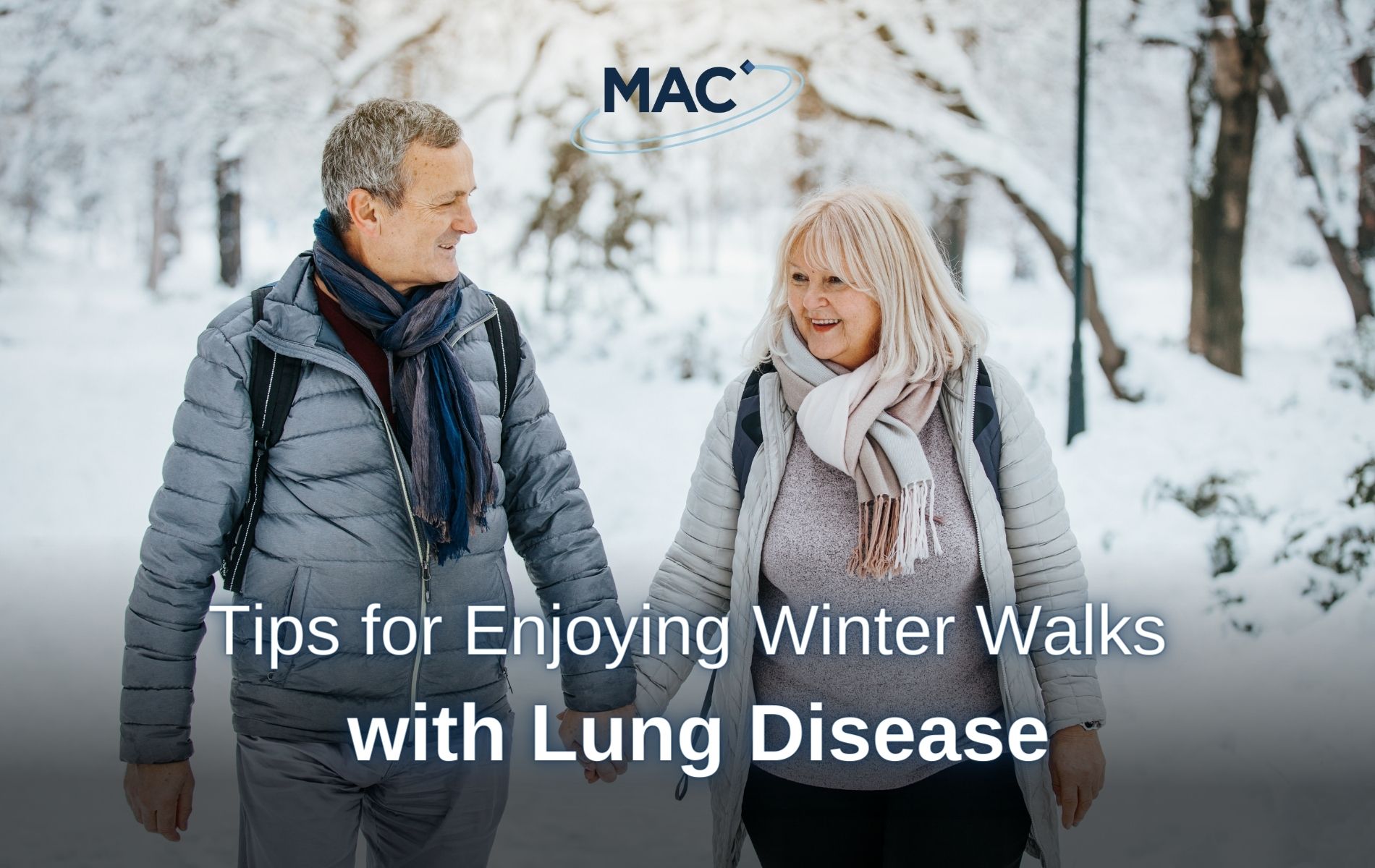This week, we’re recognising The Festival of Winter Walks which takes place on 17th December, a chance to enjoy the countryside and winter landscapes. While the allure of a brisk walk or a refreshing hike through snow-covered landscapes is appealing, for those living with lung diseases, such as COPD and IPF, safety measures must be taken to avoid the risk of exacerbating their condition.
What are IPF and COPD?
Idiopathic Pulmonary Fibrosis (IPF) is a chronic and progressive lung disease characterised by the scarring of lung tissue. It primarily affects older adults and restricts their ability to breathe easily, which can lead to severe respiratory distress, manifesting in symptoms such as chronic cough and breathlessness. The British Thoracic Society estimates that 30,000 people in the UK live with IPF1.
Similarly, Chronic Obstructive Pulmonary Disease (COPD) encompasses a group of lung conditions, such as chronic bronchitis and emphysema, which progressively impair lung function. It is most commonly caused by smoking tobacco and, according to the NHS, 1.2 million people in the UK have been diagnosed with COPD2.
Why should people with Lung Disease take precautions?
When symptoms worsen for these conditions, it’s known as a flare-up or exacerbation. These flare-ups can be caused by cold, dry weather which can be particularly dangerous for those living with severe forms of COPD and IPF.
Activities, such as walking and hiking, which could also make an individual short of breath can also increase the chances of a flare-up, depending on the severity of the condition.
Tips for Winter Walks with Lung Disease
- Consult with a healthcare professional – Before venturing on a winter walk, speak to your healthcare provider about the level of physical activity that aligns with your health condition. In studies evaluating the average walking time of patients living with COPD compared to those without the condition, the cohort living with COPD had a much lower average walking time than the healthy group3.
- Layer Up and Stay Warm – Dress warmly in layers when going outside: these can then be adjusted to regulate body temperature (loosening scarves or opening zips for example once exertion warms you up). Ensure to protect the extremities (hands, feet, neck, and head).
- Choose the Right Time – Go for walks during the warmer parts of the day during daylight hours. This can minimise the impact of cold air on the lungs and allow a clear line of sight, reducing the risk of falls in icy conditions.
- Plan Accessible Routes – When selecting walking or hiking routes, prioritise accessible paths which are well-maintained and mostly flat without any steep inclines which could increase your risk of a flare-up.
- Staying Hydrated – Although the winter temperatures may not feel as dehydrating as the summer months, it is still crucial to maintain adequate hydration to avoid exacerbating symptoms. For patients living with lung conditions like COPD and IPF, it’s recommended that they drink around 8-12 glasses of water every day4.
- Travel with a Companion – Enjoying a walk with a friend, family member, or walking group can not only make your walk more enjoyable but can also provide a safety net. In the event of any respiratory distress or fatigue, a companion can offer assistance and support.
- Be Weather Aware – Keeping an eye on weather forecasts, particularly on a mobile phone that you carry with you, to get regular updates, can keep you informed of any sudden changes in the weather which could impact your respiratory health. For IPF, studies have shown that mortality rates are at their highest during the winter, so it is essential to take extra precautions in the cold temperatures5.
- Social Distancing – To mitigate the risk of exacerbating symptoms of COPD or IPF, it’s advisable to avoid crowded areas and practice social distancing, especially during outbreaks of viral illnesses, such as the flu, which could further worsen conditions.
- Be Prepared – Ensuring essentials are kept on hand at all times is also very important. This includes items such as necessary medications, a mobile phone, and any required medical information.
The Festival of Winter Walks is a wonderful opportunity to connect with nature and prioritize overall well-being. By adopting these safety measures and incorporating personalized advice from healthcare professionals, individuals with COPD and IPF can confidently embrace winter walks, enjoying the beauty of the season while prioritizing their respiratory health.
Clinical Trials for Lung Conditions
MAC is looking for volunteers with moderate to severe COPD (aged 40-85) or IPF (aged 40+) to take part in their latest paid clinical research, investigating potential new treatment options for these conditions.
The clinical trials are running at several MAC clinics, primarily across the north of England. Eligible participants will receive reimbursement for their time and commitment to the trial, plus reasonable travel expenses will be paid, or transport provided, as well as a full medical check-up.
For more information on either of the trials, please visit our IPF Clinical Trials webpage or COPD Clinical Trials webpage.
1 British Thoracic Society – BTS ILD Registry Annual Report 2020: a summary of the UK IPF Registry for the general public
2 NHS – Digital service to manage high-risk chronic obstructive pulmonary disease (COPD) patients
3 Respiratory Research – Level of daily physical activity in individuals with COPD compared with healthy controls
4 COPD – Staying Hydrated
5 CHEST – Seasonal variation: mortality from pulmonary fibrosis is greatest in the winter






